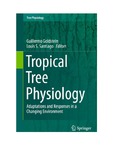| dc.rights.license | http://creativecommons.org/licenses/by-nc-sa/3.0/ve/ | |
| dc.contributor.author | Rada R., Fermin J. | |
| dc.date.accessioned | 2017-02-17T23:19:46Z | |
| dc.date.available | 2017-02-17T23:19:46Z | |
| dc.date.issued | 2016-03-04 | |
| dc.identifier.citation | Rada F. 2016. Functional Diversity in Tropical High Elevation Giant Rosettes. En: Goldstein G, Santiago LS (Eds). Tropical Tree Physiology. Springer. pg. 181-202. | es_VE |
| dc.identifier.uri | http://www.saber.ula.ve/handle/123456789/43040 | |
| dc.description.abstract | Strong daily temperature variations, seasonal soil water availability and high air evaporative demands play an essential role in adaptive responses of tropical high elevation mountain plants. Giant rosettes are a perfect example of successful adaptations to these conditions, representing an important life-form of high elevation tropical mountains in the Andes, Hawaii and Africa, a well-known case of convergent evolution. Adaptive radiation resulted in a substantially large number of giant rosette species in the ‘paramos’, a local name given for tropical alpine Andean vegetation. Plant functional responses: plant water relations, gas exchange characteristics and freezing resistance in giant rosettes are described in order to understand their responses to extreme environmental conditions characteristic of high elevation tropical habitats. Giant rosettes have a large capacitance (water-storage pith) and strong stomatal control to cope with periods of water deficit, resulting in the maintenance of high leaf water potentials on a daily and seasonal basis. Maximum net CO2 assimilation rates are variable among species (3–10 μmol m−2 s−1), all showing photosynthetic decreases from wet to dry seasons. Giant rosettes rely on permanent supercooling of the leaves together with insulating structures protecting stems and apical buds to cope with freezing damage. Even though the general aspect and plant morphology of giant rosettes is similar across all high elevation tropical regions, responses to similar selective pressures resulted in different physiological characteristics in freezing resistance mechanisms, e.g. tolerance versus avoidance, and thermal balance of the rosette. Giant rosette responses under changing global environments are also discussed. The emphasis in the description of physiological and morphological characteristics will be on South American giant rosettes due to the large number of studies and the large number of species occurring in this region. | es_VE |
| dc.language.iso | en | es_VE |
| dc.publisher | Goldstein G, Santiago LS (Eds). Tropical Tree Physiology. Springer. | es_VE |
| dc.rights | info:eu-repo/semantics/openAccess | |
| dc.subject | Gas exchange | es_VE |
| dc.subject | Leaf pubescence | es_VE |
| dc.subject | Stem capacitance | es_VE |
| dc.subject | Supercooling | es_VE |
| dc.subject | Water relations | es_VE |
| dc.title | Functional Diversity in Tropical High Elevation Giant Rosettes | es_VE |
| dc.type | info:eu-repo/semantics/article | |
| dc.description.colacion | 181-202 | es_VE |
| dc.description.email | frada@ula.ve | es_VE |
| dc.publisher.pais | Suiza | es_VE |
| dc.subject.institucion | Universidad de Los Andes | es_VE |
| dc.subject.thematiccategory | Biología | es_VE |
| dc.subject.tipo | Artículos | es_VE |
| dc.subject.unidadinv | Instituto de Ciencias Ambientales y Ecológicas (ICAE) | es_VE |
| dc.type.media | Texto | es_VE |


